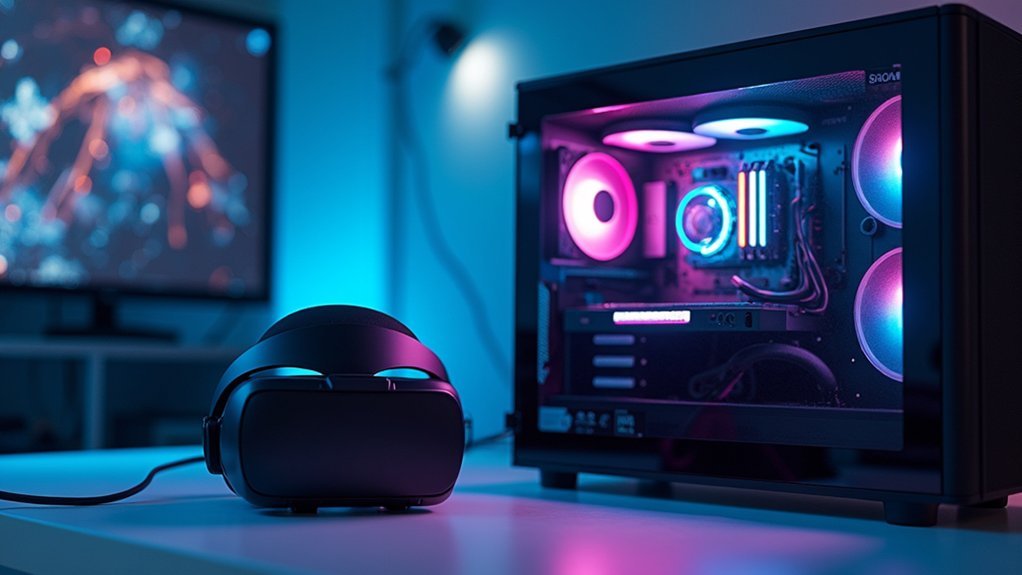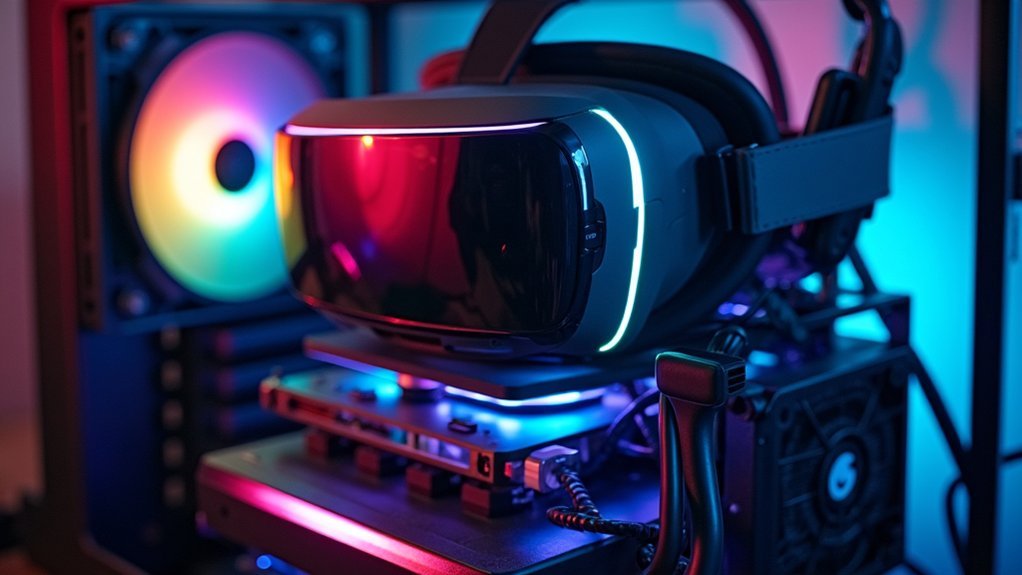You need a powerful computer for VR because your headset must render two separate high-resolution displays simultaneously at 90 frames per second to prevent motion sickness and jitters. Your GPU handles the demanding dual-display rendering at 1080×1200 resolution per eye, while your processor coordinates real-time head tracking and maintains stable frame rates. Without sufficient computing power, you’ll experience choppy visuals and frame drops that can ruin immersion. There’s much more to reflect on when building your ideal VR setup.
Understanding VR Computing Demands and Performance Requirements

When you’re considering a VR headset, you’ll quickly discover that these devices demand considerably more computing power than traditional gaming or everyday computer tasks.
Your VR experience hinges on maintaining 90 frames per second across dual displays, which requires exceptional GPU (Graphics Processing Unit) performance. Unlike standard gaming that targets 60 fps on a single monitor, VR’s refresh rate demands push your graphics cards to their limits.
VR’s dual-display 90fps requirement demands exceptional GPU performance that pushes graphics cards far beyond traditional single-monitor gaming limits.
You’ll need high-end hardware like NVIDIA GeForce GTX 1660 or better to handle the complex graphical processing required for photorealistic quality.
Without a powerful computer, you’ll experience jitters and frame drops that destroy immersion and can cause motion sickness. The demanding nature of VR rendering makes robust computing systems essential for smooth, enjoyable experiences.
Graphics Card Specifications for Optimal VR Performance
Your graphics card serves as the backbone of any VR setup, and choosing the right GPU directly determines whether you’ll enjoy seamless virtual worlds or struggle with choppy, nauseating experiences.
VR headsets demand tremendous processing power because they must render dual displays at 1080×1200 resolution while maintaining high frame rates of at least 90 fps. Without a powerful graphics card, you’ll face motion sickness-inducing frame drops and jitters.
For peak VR performance, you’ll need at least an NVIDIA GeForce RTX 2070 as your baseline.
However, if you’re pursuing photorealistic quality and realistic visuals in demanding applications, consider upgrading to an RTX 3060 Ti or higher. These GPUs handle the intensive computational requirements that transform standard gaming into truly immersive virtual experiences.
Processor Requirements for Smooth Virtual Reality Experiences

While graphics cards handle the visual rendering workload, your processor manages the complex calculations and system coordination that keep VR running smoothly.
For virtual reality to function properly, you’ll need a minimum Intel i5 or AMD Ryzen 3 processor. However, VR users seeking peak performance should consider an Intel Core i7 or AMD Ryzen 7, which provide superior core counts and processing power for demanding applications.
Clock speeds matter considerably in VR environments. You’ll want processors running at least 3.5GHz to maintain stable frame rates and prevent motion sickness.
Your CPU must simultaneously handle multiple background tasks while coordinating with your GPU to deliver seamless virtual reality experiences. A well-balanced system emphasizing both processor and graphics performance guarantees smooth interactions in immersive virtual environments.
Memory and Storage Considerations for VR Applications
Beyond processing power, memory and storage form the backbone of any capable VR system.
You’ll need at least 8GB of RAM for basic VR applications, but 32GB is recommended for smooth performance and multitasking. High-end development work may require 64GB or more to handle demanding software simultaneously.
For storage, you should prioritize SSDs over traditional hard drives.
They’ll dramatically improve boot times and application loading speeds, enhancing your overall VR experience. NVMe SSDs with M.2 connections offer the fastest data transfer rates, making them ideal for large VR applications that often exceed 100GB.
Consider both speed and capacity when choosing storage solutions.
High-quality VR content demands substantial space, so you’ll want adequate capacity alongside the performance benefits that modern SSDs provide.
Choosing Between Tethered and Standalone VR Solutions

How do you decide between tethered and standalone VR systems when both offer distinct advantages? Your choice depends on whether you prioritize graphic fidelity or portability.
Tethered VR headsets leverage powerful computers with high-performance GPUs like NVIDIA’s RTX series to deliver photorealistic visuals and seamless 90fps performance. They’re ideal for demanding VR applications like 3D design and high-end gaming that require immersive experiences with superior graphics quality.
Tethered VR systems harness desktop-grade processing power to achieve unparalleled visual fidelity and smooth frame rates for professional applications.
Standalone VR offers mobility and convenience but relies on built-in hardware that can’t match tethered systems’ visual prowess. You’ll get adequate performance for casual use, but these headsets struggle with graphics-intensive applications.
If you’re serious about VR development, professional work, or premium gaming, tethered solutions provide the computational power necessary for truly exceptional experiences.
Frequently Asked Questions
Do You Need a Powerful Computer for VR?
Yes, you’ll need a powerful computer for VR. You require a high-end graphics card, fast CPU, and SSD to render complex 3D environments at 90+ frames per second for smooth, comfortable experiences.
Why Does VR Require so Much Power?
VR demands massive power because you’re rendering two high-resolution displays simultaneously at 90+ fps while processing complex 3D environments, real-time interactions, and maintaining ultra-low latency to prevent motion sickness and preserve immersion.
How Do I Know if My PC Is Good Enough for VR?
Check your PC’s specs against VR requirements: you’ll need at least an Intel i5 or Ryzen 3, GTX 1660 graphics card, 8GB RAM, and SSD storage for smooth performance.
Do VR Headsets Need a PC?
Not all VR headsets need a PC. You’ll find standalone headsets like Quest that work independently, while tethered headsets like Rift require a powerful computer for peak graphics and performance.
In Summary
You’ll need a powerful computer for VR because your headset demands real-time rendering of two high-resolution displays at 90+ fps. Your graphics card must handle complex 3D environments while your processor manages tracking calculations and game logic simultaneously. You can’t compromise on RAM or storage speed either, as they’ll directly impact your experience. Whether you choose tethered or standalone VR, understanding these requirements guarantees you’ll enjoy smooth, immersive virtual worlds without motion sickness or lag.





Leave a Reply